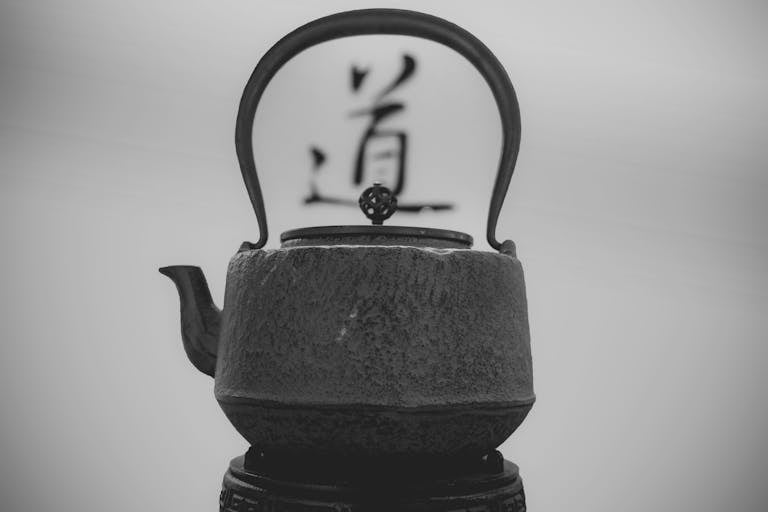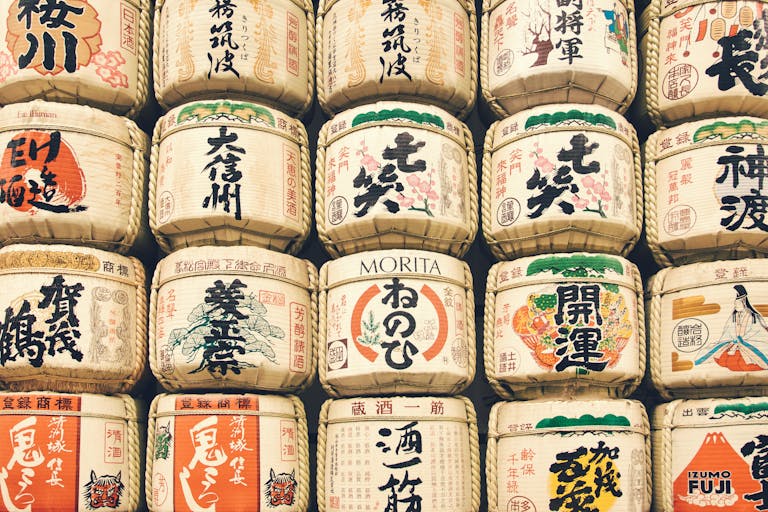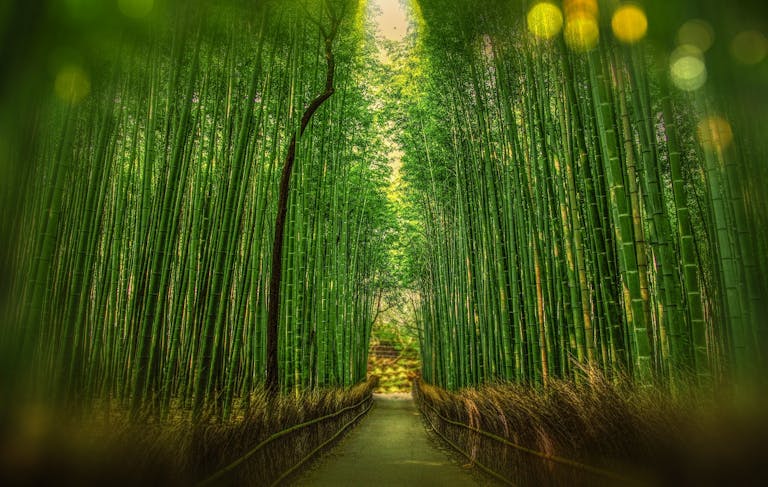From Kool-Aid to Green Tea: Tales of My Cult Childhood

Introduction
I was typing about Shinto’s history, reflecting how its noble origin has shaped Japanese culture since ancient times. Then a distant memory bubbled up: I was 5 or 6, standing before a beautiful Shinto shrine gate, torii (鳥居, a gate into sacred). I wanted to walk through it, but my parents stopped me, saying it was jadō (邪道, a wicked wrong course) and couldn’t go near it. I never did, for my entire childhood. That memory stopped me in my tracks, triggering an avalanche of realization about my upbringing— sitting straight, kneeling with my feet under my butt and chanting the same word for hours, being told that this practice would save my soul, and the world, that it was the highest and only path of Buddhism that everyone in the world needed to embrace. Though I’ve been out of my country for 20 years and stopped participating in the religion when I came to America as a student, it took until now to fully understand: I was raised in a cult.
This realization inspired me to follow the rabbit hole for deeper and darker truths hidden beneath the surface of my childhood, and a discovery of my lost fragment of spirituality on this ancestral healing journey.
In this post, I will ramble on about this religious organization (or a cult), Soka Gakkai, its history, their tactics, how it is to grow up in it, its dark side, and the complications of organizations like Soka Gakkai or SGI today, collecting yet another piece of my Japanese cultural puzzle. Without any due, let’s get started!
Soka Gakkai’s Beginnings
Soka Gakkai (創価学会, ‘value-creation’ society) is a new religious movement founded in 1930 Japan, based on the teachings of Nichiren (日蓮), a Japanese buddhist priest from 13th century, and it is the largest, most influential and also most controversial sect of Nichiren Buddhism in the world today. Nichiren Shōshū is an obscure sect of Buddhism in Japan (more on that later). The society originated as a lay buddhist movement to educate children to be dignified individual citizens, rather than a mere resource or servants for the military state. The founder Tsunesaburo Makiguchi was arrested during World War II for violating the Japanese military regime’s regulations and died in prison as a result of malnutrition and repeated interrogation in 1944. Makiguchi’s disciple and also his successor Jōsei Toda studied Lotus Sutra, one of the most famous, influential and venerated Buddhist scriptures, while in prison, and had an enlightening conversion experience that he decided to spread the word to people. He reinterpreted the translations and teachings of it by Nichiren Buddhism to adapt it to the everyday people’s needs.
Championing the Poor, Sick and Disempowered
When he was released from the prison in 1945, Toda was on a mission to rebuild Soka Gakkai and spread Nichiren Buddhism as wide as possible. People were desperate for something to hold on to in post war Japan as there was much confusion, poverty, and despair among people. My grandparents on both mother and father sides were those people in postwar, devastated Tokyo. As such, the new religious movement led by Toda grew rapidly like a wildfire, quickly becoming the largest lay Buddhist movement in Japan. The organization kept its focus on education, but also expanded to champion the rights of the sick, poor, and disempowered, and strongly opposed proliferation of nuclear weapons. By the time of his death in 1958, Toda grew Soka Gakkai into a movement with membership of 750,000 households all over Japan. This massive and rapid growth was a result of extreme and forced proselytizing called shakubuku (折伏, conversion) which every member of Soka Gakkai, especially the energetic youth groups, was instructed that shakubuku is the highest form of service and practice to induce the inner Buddha life force and lead to individual empowerment that Toda called “Human Revolution”.
Daisaku Ikeda Takes Soka Gakkai to Overseas
Among those energetic youths was Daisaku Ikeda, who was Toda’s protege and climbing up the religious hierarchy ladder as a young lad; from being a Soka Gakkai’s youth leader to a director of the public relations bureau to then a chief of staff. In 1960, 2 years after Toda’s death, Ikeda succeeded as the third president of Soka Gakkai. That’s when Ikeda began traveling around the world to spread the words of Nichiren Buddhism and peace philosophy, recruiting the first international members to join Soka Gakkai, which later founded as Soka Gakkai International, or SGI. According to their website there are 3 million SGI members in 192 countries world wide, and in Japan there are 8.27 million member ‘households’ today. That’s close to 10 % of the Japanese population if you consider children of those member households who are automatically members by being born into the member families, just like I was. This is a significant percentage of the population identified as religious, considering that Japanese people culturally are not very religious, but have customs and traditions that are based on ancient Shinto animism philosophies as I wrote in this post. Ikeda had to resign his position as a president in 1979 which I will get to a bit later, and instead became an “honorable president” of Soka Gakkai which seemed to have given Ikeda even more power and authority than before. Ikeda was loved, revered and even worshipped as sensei (先生, teacher, master) by Soka Gakkai members until his recent death in 2023 at age 95.
Concerning Aspects of Soka Gakkai Movement
While I support the face values of non-violence, peace, personal empowerment, value-creation, and education, when these noble values are used as tools for control and manipulation, they become poisons for the consciousness of people. The brainwashing process in Soka Gakkai is gradual and subtle, yet thorough – like getting Kool-Aid through an IV drip while your consciousness slowly transforms and weakens. Here are the key concerning aspects I’ve identified:
False Buddhist Foundations
I wrote earlier that Ikeda had to resign as an official president of Soka Gakkai in 1979. This was because of the assertion by Nichiren Shōshū sect of Buddhism, which Soka Gakkai claimed to be basing all of its philosophy and teachings from. Soka Gakkai was excommunicated by its mother organization Nichiren Shōshū Buddhism sect in 1991 because it violated the practice guidelines and repeatedly attacked the sect in public. After this event, Soka Gakkai rewrote its governing rules, and also announced to its faithful members that the organization was now “spiritually independent” and claimed that it was the only organization truly following Nichiren Buddhism and therefore only its members can achieve Buddhahood through Soka Gakkai’s practice. What’s even more shocking is that Soka Gakkai would begin distributing its own home-made gohonzons (ご本尊, principal image of worship) that were copies of an original one inscribed by 26th High Priest Nichikan.
Worse yet, Nichiren’s teachings aren’t even considered Buddhism by many Buddhist sects and societies. Nichiren’s teaching, “anyone who chants Nam Myō Hō Renge Kyō will achieve Buddhahood from within” and even this chant have never been taught or written by Buddha himself anywhere in the thousands of Buddhist scriptures. Teachings that are not directly from Buddha are not inherently Buddhism. Rather, Buddha taught to dispute and question everything. Nichiren denied and negated any other sects of Buddhism, claiming that his teachings alone can induce enlightenment. He even advised the emperor of Japan at the time to execute anyone who opposes his teachings. Nichiren Shōshū is a pseudo Buddhist sect that worships Nichiren above Buddha himself. Well, this whole philosophy is the basis for Soka Gakkai. There’s no mystery that a movement born out of a cult can also only be a cult.
Political Power and Control
In 1964, Daisaku Ikeda founded Kōmeitō, a Japanese political party as an outgrowth of Soka Gakkai. This of course received raging criticisms from the society as it violates the separation of religion and the state. In 1970, Soka Gakkai announced the separation of the Kōmeitō party from it. It might be superficially and structurally separate, but any children in the Soka Gakkai households know—their parents are extremely busy during the election seasons, trying to collect more votes outside Soka Gakkai on top of 8 million member votes that are already secured. Considering that there is only about 50 % turn over for elections in Japan, that’s a significant number of votes secured. Additionally, Kōmeitō has successfully attached itself to the leading party in Japan, Liberal Democratic Party, forming a coalition influencing Japanese policies with Soka Gakkai agendas to this day. The party has at its disposal the members of Soka Gakkai working as party staff during the time of election. And these members are told that election activities are part of religious practice and ‘the victory’ (in election) will further bring more fortune, prosperity and enlightenment. The members do not question the policies of the party, because it naturally aligns with their religious organization Soka Gakkai. If that is not brainwashing, I don’t know what is.
The Ikeda Cult of Personality
Ikeda resigned his position as the third president of Soka Gakkai responding to the assertion made by Nichiren Shōshū, and instead stepped into the position of Honorable President of Soka Gakkai. What the heck is the honorable president anyway? I remember seeing Ikeda on a big screen being broadcasted at every gathering that my parents took me to. In the broadcast, Ikeda usually walks into a room filled with hundreds if not thousands of people, men, women and children and receives a great almost hysteric applause from them; it’s almost like a rock concert or something. And of course everyone watching the broadcast on a screen in the room with me applause too. Ikeda finally sits down after an entrance ordeal, then speaks a few words of this and that about peace, victory and hope. It was always about peace, victory and hope, which are great values but very abstract for everyday life of a regular people and doesn’t relate to the specific actions. Ikeda is called sensei (先生, a teacher, a master) by the members, and he is revered, seemingly above Buddha or Nichiren himself, to this day, 2 years after his death. Huge portrait photographs of Ikeda and his wife are hung in every hall. Soka Gakkai members will never say or do things against Ikeda; having a humble beginning as a poor lad, he was everyone’s hero and God. I never understood as a child what all adults saw in him to make them worship this man who was, to me, just a greasy fat old dude whose words never moved me in any way. Why did Ikeda wield so much power and charisma on Soka Gakkai members even though he wasn’t personable, intelligent, or particularly good at speech? Ikeda had never even demonstrated any miraculous healing or enlightenment like Jesus or Buddha once did. It is a great mystery. There are many sources outside Soka Gakkai describing the great financial wealth and extravagant spending habits that Ikeda possessed, and his self-serving egocentric pursuit of power and greed, as Polly Toynbee, a granddaughter of respected English philosopher and historian Arnold Toynbee, writes in her article about her experience meeting Ikeda on Guardian in 1984:
“Worldly, he seemed, down to the tip of his hand-made shoes, earthy almost, without a whiff of even artificial spirituality. Asked to hazard a guess at his occupation, few would have selected him as a religious figure. I have met many powerful men—prime ministers, leaders of all kinds—but I have never in my life met anyone who exuded such an aura of absolute power as Mr. Ikeda. He seems like a man who for many years has had his every whim gratified, his every order obeyed, a man protected from contradiction or conflict.”
Ikeda met with Arnold Toynbee at his old age right before his final incapacitating stroke, to exchange a few words. These words are published as books and aggressively promoted by Soka Gakkai to its members, saying “another great conversation of peace between Ikeda and a great philosopher of our time! Look how great your religious leader is!” This is far from the truth as stated in Polly’s article. She writes:
“My grandfather never met Ikeda on his visits to Japan. His old Japanese friends were clearly less than delighted with Ikeda’s grandiose appropriation of his memory, on the basis of a handful of rather vague interviews in extreme old age.”
The Ikeda followers would never even imagine this Ikeda’s dark side because that concept doesn’t even exist in their consciousness; they have been successfully brainwashed, and that’s what I will get to next.
Indoctrination Machine
In my household, the only newspaper that we got was seikyō shimbun (聖教新聞, ‘sacred teaching’ newspaper) which they claimed some whopping 5 million in circulation. My parents told me that in this modern society with a lot of depressing news everyday, seikyō shimbun was the only newspaper with positive, and uplifting, hopeful news. I mean, uplifting positive news are great and all, but things that I often saw in the paper were rather propaganda fake news that Ikeda did this and that for world peace or Ikeda just ‘received’ yet another professor emeritus from prestigious universities all over the world, which were purchased with the member’s donations rather than ‘awarded’ to him. Ikeda holds over 400 of these labels purchased from various institutions. They serve as two things; solidifying Ikeda’s image as a great leader for Soka Gakkai members, and great indoctrinating content for the newspaper. Propaganda and brainwashing do not stop with the newspapers; there are also over 160 books (ghost-written) by Ikeda published from Soka Gakkai private publishing press. The members are encouraged to purchase them and study them as if they are the holy religious scriptures. I don’t remember studying actual scripture even once in my childhood but I remember that local member meetings often studied and discussed the New Human Revolution, a longest-run newspaper column novel in all Japan and a lengthy story of Ikeda’s own life put together and published as 30 books. My father sent me many of these books over the years from Japan, but unfortunately none of them did anything to me; I threw them away feeling guilty every time for not being able to reciprocate my father with understanding Ikeda’s apparent greatness. Daily newspaper circulation and numerous books together create extremely powerful and constant indoctrination programming for Soka Gakkai members and also a massive income stream for the organization, or mostly just for Ikeda. The members are paying to be continuously brainwashed; This is an insidious cycle.
My Personal Journey
Early Days
As you’ve already figured out, my childhood was heavily colored by daily experiences of Soka Gakkai which I now definitely know to be a cult. I was born into a family as the third generation member of Soka Gakkai. My grandparents, parents and relatives from cousins to aunties were all Soka Gakkai members. Many of the neighbors we often saw were also members. Of course there was no question asked, and I had no choice as I was automatically a member at the moment of my birth which is considered extremely fortunate in the cult. My sister and I were taught to participate in daily practice of gongyo (勤行, reading a part of lotus sutra) and chanting Nam Myō Hō Renge Kyō in the mornings and evenings, and various activities in youth groups such as choir and study meetings. I don’t have a whole lot of memories of my parents playing with us, or spending time as a family because their evenings and weekends were busy with gatherings, and meetings in their own men’s division and women’s divisions and such. I wasn’t angry or anything; I just didn’t know any other way of living. Activities in Soka Gakkai were a huge part of my parents’ lives and so were ours as kids. I neither enjoyed nor disliked it.
Middle School & High School
My teenage years brought increased pressure from the young women’s division. Members 5-10 years older than me visited multiple times weekly, pushing me to attend meetings and participate in recruitment activities. We were instructed to collect classmates’ personal information through New Year’s greeting cards—data that would later be used for election campaigns and shakubuku (折伏, conversion). They promised that bringing in new newspaper subscribers and new members to the group meetings would increase my fortune and Buddha life force.
This was when my doubts began crystallizing. When I sought life advice from my dad, his answer was simply, “just chant more and you will find the solution.” His response left me deeply disappointed and disenchanted. I was also freaked out by my near-future outlook of becoming like the young women’s division members— people whose entire lives revolved around religious (cult) activities rather than personal growth and real life experiences.
During this time, my mother unexpectedly passed away from breast cancer when I was 14. This was somewhat a big deal for myself and my sister, but local Soka Gakkai families provided tremendous support for us with food and care—highlighting one of the organization’s complexities. Most members were genuinely good, caring people, but their strong sense of community and belonging came at the cost of independent critical thinking. They were blind to red flags that, in retrospect, were glaringly obvious.
College and Leaving Home
After graduating from high school in 2004, I decided to study abroad following my mother’s last words to me—”get out to the world”. I was strongly encouraged by many around me to apply for a brand new (at the time) Soka University of America in Orange County California as it is a great honor for the Soka Gakkai families that their kids study in Soka schools founded by Ikeda. I thank God to this day that I didn’t get accepted. I would have been still trapped in the Ikeda cult if I went there. Phew. A small community college in Wyoming happily accepted me with a scholarship, and this was my escape from a life of cult. Of course, I didn’t fully understand at the time that I was escaping Japan for the cult. I just knew I needed to get away. Having the physical distance from the cult, and dramatically changing my environment helped me to really widen my perspective on life and explore my own innate spirituality that I couldn’t access in Japan. During my first year of college, I was encouraged by my dad to find local members of SGI, Soka Gakkai International, and keep on revering and chanting to the tiny plastic portable Gohonzon (ご本尊, copy of the principal image of worship) which I was told to be very sacred. It is repeatedly told to the members that leaving Soka Gakkai will lead them to misfortunes and eventually to hell. That statement is firmly believed among Soka Gakkai members, but with a little bit of distance between myself and them, I was able to see the obvious indoctrination and lies through it. The spell on me was starting to break. I went to one meeting in Wyoming which made me confirm that I was completely done with it. Then, I threw this plastic Gohonzon away to see if I would really go to hell or not.
I’m very happy to say that my life has never been more wonderful and adventurous today.
What I Learned from My Realization
I already knew I didn’t want to be a part of Soka Gakkai years ago, but it was quite a shock for me to realize it is not a religion but rather a cult. I was raised in a cult from my birth. It took me a distance as big as the Pacific ocean and 20 whole years away from it to finally realize it. No one was really allowed to question the legitimacy of teachings, philosophy or Ikeda’s words in Soka Gakkai, and any of my questions were usually answered by “more chanting”. I was so wrapped up in the world of Soka Gakkai that I feel like I have many blind spots on my consciousness that I am not aware of.
Looking back now, I can see how the organization’s structure perfectly embodied the classic hallmarks of a cult: the unquestionable leader figure, the fear-based retention (“you’ll go to hell if you leave”), the isolation from other belief systems (like being forbidden from visiting Shinto shrines), continuous brainwashing and the constant pressure to recruit others. What’s particularly insidious is how these controlling mechanisms were wrapped in the language of enlightenment and world peace.
The most profound lesson for me has been understanding how good people, like my parents, grandparents, and local families who supported us through rough times, can become deeply embedded in such insidious programs while genuinely believing they’re doing what’s good for the world, especially when they are consciously vulnerable as in postwar disaster. I feel a strong anger and unfairness for those vulnerable to be used and taken advantage of by a cult leader in pursuit of his own green during the time of crises. There’s also a certain sadness in recognizing that my parents’ devotion to Soka Gakkai, while well-intentioned, actually limited their ability to discover their own spirituality, to experience authentically, and to connect with their children in more meaningful ways.
Conclusion
Breaking free from Soka Gakkai wasn’t just about leaving a cult—it was also about reclaiming my innate right to question, to explore, and to define my own spiritual path. While my journey from Kool-Aid to green tea has been long and sometimes unsure, it has led me to a place of genuine spiritual freedom, self-discovery, and hope for ancestral healing of my lineage.
Today, I can appreciate my mother’s last words, “get out to the world” creating my pathway not just out of Japan, but out of the generations of a cult which would have continued to prison my consciousness and worldview. She was praying a lot with the only way she knew how—chanting for hours, leading up to the moment of her death. Maybe her prayer came from an unconscious deeper place, her soul to be freed and healed from the spiritual bondage of Soka Gakkai cult. I feel that’s probably why she left me with those parting words. Now I know that true enlightenment doesn’t come from unquestioning devotion to any organization or leader, but from having the courage to think independently, to face my own and my ancestor’s dark sides, and to deepen the connection to my own true nature.
For those still within Soka Gakkai or other cults who might be questioning their involvement, know that there is life—beautiful, rich, meaningful life, outside these controlling systems. The hell they threaten you with doesn’t exist, but the reality of personal freedom and authentic spirituality does if you are willing to search for it. . Sometimes, as in my case, it takes physical distance to gain mental clarity. Wherever you are, the first step is always the same: allowing yourself to question, borrowing wise words from Buddha.
We are now at the stopping point of this ramble together. Thank you for sticking with me! This was another transformational ramble for me as it helped me integrate my fragmented spirituality and childhood through a realization that I was raised in a cult. Raised in a cult! I have never ever imagined once in my life until now that I would ever say this. But I was and I did. I hope that you got something valuable out of this ramble together. And if you like, please feel free to write to me with any opinions, feelings, requests, questions, or greetings using the comment section below or direct contact. If you would like to receive my periodic newsletter for some Japan trip tips, hidden gems, recipes and such, you can sign up from the homepage! (this is a cult and indoctrination free I swear!) Until next time my friends, 元気でね!Take care!
Little Bonus
Books specifically about SGI/Nichiren Buddhism experiences:
“Polly: Memories of an East Los Angeles Bank Owner” by Polly Tokunaga (includes her SGI experience)
“The Buddha in Your Mirror” (to understand what current members are reading/influenced by)
“Cult to Christ: The Church With No Name and the Legacy of the Living Witness Doctrine” by Elizabeth J. Coleman (includes SGI chapter)
Online Communities and Blogs:
r/sgiwhistleblowers (very active Reddit community)
r/exSGI (support-focused community)
“SGI Cult Info Blog” (extensive documentation)
Rick Ross Forum’s SGI discussion threads
Facebook groups for former members (though I should note these should be verified as some may still be pro-SGI)
Notable Websites/Archives:
cuke.com (David Chadwick’s archive, includes some SGI history)
cultawarenessnetwork.org (has SGI-specific resources)
“The Owl in the Olive Tree” blog (critical analysis of SGI practices)






